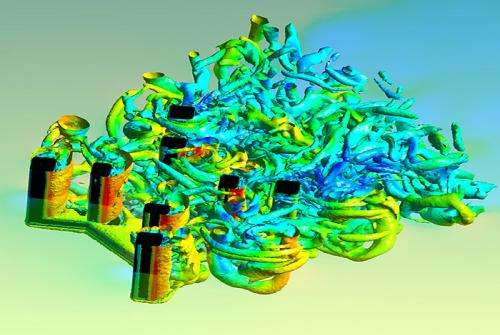A simulation of vortex induced motion shows how ocean currents affect offshore oil rigs.
Los Alamos National Laboratory mechanical and thermal engineering researchers' efforts to solve the complex problem of how ocean currents affect the infrastructure of floating oilrigs and their computational fluid dynamics (CFD) numerical simulations received recognition from ANSYS Inc., a company that provides computer-based engineering simulation capabilities.
"Because energy resources are in demand, and most of the Earth is covered by water, we are going into deeper and more challenging waters to meet our energy needs," said Dusan Spernjak, of the Laboratory's mechanical and thermal engineering team. "Designing a floating structure for offshore deep water oil drilling is a challenging task because drilling starts deep under the sea surface with no infrastructure in place."
Vortex-induced motion (VIM) is a complex problem that occurs when there are highly turbulent flow and fluid-solid interaction phenomena. The available experimental data are very limited, especially from field measurements. The large size of the problem and complex physics calls for advanced numerical simulations using supercomputers to solve VIM.
Spernjack said that it is important to minimize the motion of drilling platforms caused by vortex shedding from ocean currents. Vortex shedding affects the integrity of key components such as riser and mooring systems of the offshore drilling station, which directly impact system safety.
In the vortex-induced motion study, Los Alamos researchers focused on the motion of the floating structure resulting from complex fluid-structure interaction and vortex shedding from sea currents. The team performed a comprehensive parametric sensitivity study in which they tested different turbulence models and other modeling parameters. The researchers confirmed the computational fluid dynamics results using extensive experimental measurements in a tow tank facility, which tests hydrodynamics and creates functional waves.
The simulations reveal insights into the physics of vortex shedding and VIM at different length and time scales. The immediate benefits include the improved process for design optimization for large floating structures, and possible strategies for vortex-induced motion improvement.
The Los Alamos mechanical and thermal engineering team's CFD project finished as a finalist in ANSYS's Hall of Fame.
"Recognition from ANSYS for our effort to improve offshore drilling safety brings global exposure to the diverse science and advanced engineering conducted by the Laboratory and our team," Spernjak said. "Making their Hall of Fame is the result of a great team effort, from our postdoc Seung Jun Kim to our industry partners, with support from Los Alamos high-performance computing."
Provided by Los Alamos National Laboratory























